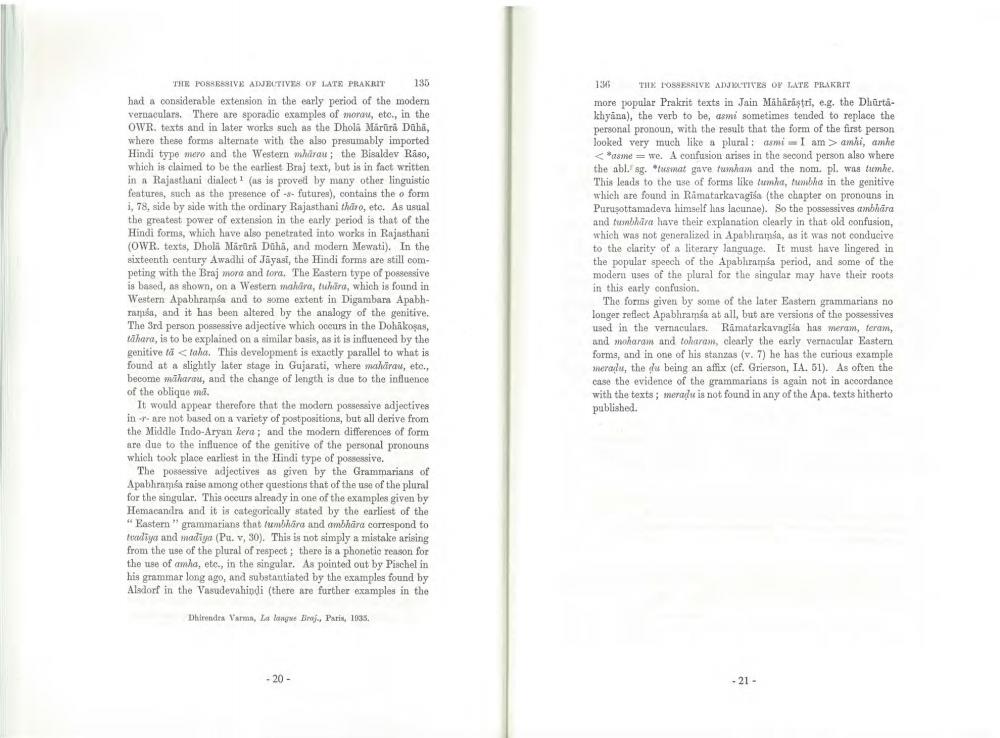________________
THE POSSESSIVE ADJECTIVES OF LATE PRAKRIT
135
had a considerable extension in the early period of the modern vernaculars. There are sporadic examples of morau, etc., in the OWR. texts and in later works such as the Dhola Marürü Dühä, where these forms alternate with the also presumably imported Hindi type mero and the Western wharau; the Bisaldev Raso, which is claimed to be the earliest Braj text, but is in fact written in a Rajasthani dialect 1 (as is proved by many other linguistic features, such as the presence of -s- futures), contains the o form i, 78, side by side with the ordinary Rajasthani tharo, etc. As usual the greatest power of extension in the early period is that of the Hindi forms, which have also penetrated into works in Rajasthani (OWR. texts, Dhola Märärä Düha, and modern Mewati). In the sixteenth century Awadhi of Jayasi, the Hindi forms are still competing with the Braj mora and tora. The Eastern type of possessive is based, as shown, on a Western mahara, tuhara, which is found in Western Apabhramsa and to some extent in Digambara Apabhramsa, and it has been altered by the analogy of the genitive. The 3rd person possessive adjective which occurs in the Dohākosas, tahara, is to be explained on a similar basis, as it is influenced by the genitive ta taha. This development is exactly parallel to what is found at a slightly later stage in Gujarati, where mahārau, etc., become maharau, and the change of length is due to the influence of the oblique ma.
It would appear therefore that the modern possessive adjectives in -- are not based on a variety of postpositions, but all derive from the Middle Indo-Aryan kera; and the modern differences of form are due to the influence of the genitive of the personal pronouns which took place earliest in the Hindi type of possessive.
The possessive adjectives as given by the Grammarians of Apabhramsa raise among other questions that of the use of the plural for the singular. This occurs already in one of the examples given by Hemacandra and it is categorically stated by the earliest of the "Eastern" grammarians that tumbhara and ambhara correspond to teadiya and madiya (Pu. v, 30). This is not simply a mistake arising from the use of the plural of respect; there is a phonetic reason for the use of amha, etc., in the singular. As pointed out by Pischel in his grammar long ago, and substantiated by the examples found by Alsdorf in the Vasudevahindi (there are further examples in the
Dhirendra Varms, La langue Braj, Paris, 1035.
-20
136
THE POSSESSIVE ADJECTIVES OF LATE PRAKRIT
more popular Prakrit texts in Jain Mähäräştri, e.g. the Dhartakhyana), the verb to be, asmi sometimes tended to replace the personal pronoun, with the result that the form of the first person looked very much like a plural: asmi I am > amhi, amhe <*asme=we. A confusion arises in the second person also where the abl. sg. tusmat gave tumham and the nom. pl. was tumhe. This leads to the use of forms like tumha, tumbha in the genitive which are found in Ramatarkavagiša (the chapter on pronouns in Purusottamadeva himself has lacunae). So the possessives ambhara and tubhara have their explanation clearly in that old confusion, which was not generalized in Apabhramsa, as it was not conducive to the clarity of a literary language. It must have lingered in the popular speech of the Apabhiramsa period, and some of the modern uses of the plural for the singular may have their roots in this early confusion.
The forms given by some of the later Eastern grammarians no longer reflect Apabhramsa at all, but are versions of the possessives used in the vernaculars. Ramatarkavaglia has meram, teram, and moharam and toharam, clearly the early vernacular Eastern forms, and in one of his stanzas (v. 7) he has the curious example meradu, the du being an affix (cf. Grierson, IA. 51). As often the case the evidence of the grammarians is again not in accordance with the texts; meradu is not found in any of the Apa. texts hitherto published.
-21




